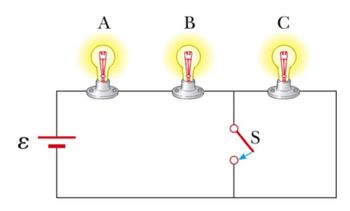
College Physics
11th Edition
ISBN: 9781305952300
Author: Raymond A. Serway, Chris Vuille
Publisher: Cengage Learning
expand_more
expand_more
format_list_bulleted
Concept explainers
Question
thumb_up100%
Three identical lights are connected to a battery as shown. Does the battery drain faster if the switch is open or closed? Explain. (You can ignore the internal resistance of the battery).

Transcribed Image Text:E
A
B
C
Expert Solution
This question has been solved!
Explore an expertly crafted, step-by-step solution for a thorough understanding of key concepts.
This is a popular solution
Trending nowThis is a popular solution!
Step by stepSolved in 4 steps with 3 images

Knowledge Booster
Learn more about
Need a deep-dive on the concept behind this application? Look no further. Learn more about this topic, physics and related others by exploring similar questions and additional content below.Similar questions
- 7 puan 4) A battery with unknown emf (e) and internal resistance (r) is connected to a circuit that involves an ideal voltmeter, a switch, and two resistors R1 =1 Q, R2 =10 Q, as shown below. When the switch is connected to a, the voltmeter reads 7 V. When the switch is connected to b, the voltmeter reads 10 V. Calculate the value of the internal resistance r. ET RI Rz 0.12 0 1.00 Q 0.25 0 0.50 0 O 0.75 0arrow_forward| C:/Users/tylrg/Downloads/Hw-7-Electric-circuits-II.pdf The diagram below shows a small water heater that uses electrical energy to heat water. The heating element is a small resistor labeled R1oad = 5.0 N immersed in the water. A 20 V ideal emf device supplies current and there is an adjustable resistor Ra in series. The value of the adjustable resistance can be changed to be anywhere between 1.0 - 3.0 N. The adjustable resistor is initially set to 2.0 Q and the switch is closed. (a) What is the voltage drop across the heating element? (b) How much energy is supplied by the source if the water heater runs for 10 minutes? (c) What fraction of this energy is actually used to heat the water? Please express your answer as a percentage, using only two significant figures. (d) Suppose the heating element degrades and corrodes and its resistivity slowly increases as the equip- ment becomes older. • Does the voltage drop across the heating element increase, decrease or remain the same as the…arrow_forwardThe pedestrian crossing of Washington Road and Ivy Lane (near the Physics building) needs a back-up battery in event of power failure. In order for the three lights to be bright enough to be seen in daylight, each of the three RL = 50 N lights must dissipate P = the 3 lights are connected in parallel (see the drawing), and the open circuit voltage of the battery (that is, the voltage when there is no current) is Vo = 110 volts. What is the maximum internal battery resistance R; allowable given that each lamp must dissipate 220 watts? 220 watts. Suppose %3D %3D Ri Vo RL pyriarrow_forward
- Consider the circuit below. The battery has emf 80.0 V, R1=40 ohms, R2= 20 ohms and L= 5.0 mH. Initially the switch is open and no currents are flowing. What is the current through the battery immediately after the switch is closed? a) zero b) 1.3 A c) 2.0 Aarrow_forwardSuppose the following circuit is left open for a long time. 24 V- 5000 Ω 80 mF (a) What is the charge on the capacitor 90s after we close the switch? (b) What is the potential difference across the capacitor 90s after we close the switch? (c) What is the potential difference across the resistor 90s after we close the switch?arrow_forwardWhen using an ammeter to measure current: Group of answer choices open the circuit at the positive and negative terminals of the battery. open the circuit and connect the meter in series between the two open ends. open the circuit at one point and connect the meter to one end. connect the meter across the battery or load.arrow_forward
arrow_back_ios
arrow_forward_ios
Recommended textbooks for you
 College PhysicsPhysicsISBN:9781305952300Author:Raymond A. Serway, Chris VuillePublisher:Cengage Learning
College PhysicsPhysicsISBN:9781305952300Author:Raymond A. Serway, Chris VuillePublisher:Cengage Learning University Physics (14th Edition)PhysicsISBN:9780133969290Author:Hugh D. Young, Roger A. FreedmanPublisher:PEARSON
University Physics (14th Edition)PhysicsISBN:9780133969290Author:Hugh D. Young, Roger A. FreedmanPublisher:PEARSON Introduction To Quantum MechanicsPhysicsISBN:9781107189638Author:Griffiths, David J., Schroeter, Darrell F.Publisher:Cambridge University Press
Introduction To Quantum MechanicsPhysicsISBN:9781107189638Author:Griffiths, David J., Schroeter, Darrell F.Publisher:Cambridge University Press Physics for Scientists and EngineersPhysicsISBN:9781337553278Author:Raymond A. Serway, John W. JewettPublisher:Cengage Learning
Physics for Scientists and EngineersPhysicsISBN:9781337553278Author:Raymond A. Serway, John W. JewettPublisher:Cengage Learning Lecture- Tutorials for Introductory AstronomyPhysicsISBN:9780321820464Author:Edward E. Prather, Tim P. Slater, Jeff P. Adams, Gina BrissendenPublisher:Addison-Wesley
Lecture- Tutorials for Introductory AstronomyPhysicsISBN:9780321820464Author:Edward E. Prather, Tim P. Slater, Jeff P. Adams, Gina BrissendenPublisher:Addison-Wesley College Physics: A Strategic Approach (4th Editio...PhysicsISBN:9780134609034Author:Randall D. Knight (Professor Emeritus), Brian Jones, Stuart FieldPublisher:PEARSON
College Physics: A Strategic Approach (4th Editio...PhysicsISBN:9780134609034Author:Randall D. Knight (Professor Emeritus), Brian Jones, Stuart FieldPublisher:PEARSON

College Physics
Physics
ISBN:9781305952300
Author:Raymond A. Serway, Chris Vuille
Publisher:Cengage Learning

University Physics (14th Edition)
Physics
ISBN:9780133969290
Author:Hugh D. Young, Roger A. Freedman
Publisher:PEARSON

Introduction To Quantum Mechanics
Physics
ISBN:9781107189638
Author:Griffiths, David J., Schroeter, Darrell F.
Publisher:Cambridge University Press

Physics for Scientists and Engineers
Physics
ISBN:9781337553278
Author:Raymond A. Serway, John W. Jewett
Publisher:Cengage Learning

Lecture- Tutorials for Introductory Astronomy
Physics
ISBN:9780321820464
Author:Edward E. Prather, Tim P. Slater, Jeff P. Adams, Gina Brissenden
Publisher:Addison-Wesley

College Physics: A Strategic Approach (4th Editio...
Physics
ISBN:9780134609034
Author:Randall D. Knight (Professor Emeritus), Brian Jones, Stuart Field
Publisher:PEARSON